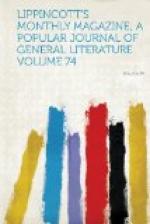To return, however, to what I was saying about that large portion of the works of art and art-industry every year exported from Italy, mainly by individual buyers for the gratification of their own taste, which consists of imitations. It may be remarked, especially as regards the objects belonging to the latter category, that these imitations, if bought as such, are not undesirable purchases. In many instances, particularly in those of iron- and bronze-work, intarsia, and carving in wood, the modern Italian artists, who began as imitators, have attained a degree of excellence which entitles them to take rank as the founders of a new artistic renaissance, while their familiarity with cinque-cento art and the loving study of it have led them to produce work in each of the above-named branches which is calculated to improve the taste of both workers and purchasers in countries beyond the Alps. As regards metal-work, whether in iron or bronze, avowedly modern, but of the true cinque-cento type and style, the amateur would do well to visit the foundries and workshops of Venice; for intarsia he may go to Milan; for wood-carving to Florence, Siena and Perugia; to the last also for intarsia. He will find in Perugia work both in carving and intarsia on which he might spend his money very much more advantageously than in buying second-rate bits of really old wood-work, or indeed any such bits as he is at all likely to meet with. And it is not surprising that the little Umbrian hill-city should have become a special home for this particular branch of art; for it contains some of the most remarkable works of the kind extant, the product of some of the most renowned masters of the craft in the fifteenth and sixteenth centuries. It is a mistake to suppose, as many persons do, that the fine works of this kind which we still admire were the product of men who were considered in their day as mere artisans, and whose names were not known beyond the boundaries of their native provinces. They were recognized as true artists, whose names were known from one end of the Peninsula to the other, and who were sent for from distant cities to execute works of importance. In many cases their names have perished: in more they are unknown to the present generation of art-lovers—caruerunt quia vate sacro. And in some cases—as a very notable instance, to be mentioned presently, will show in a remarkable manner—the higher




